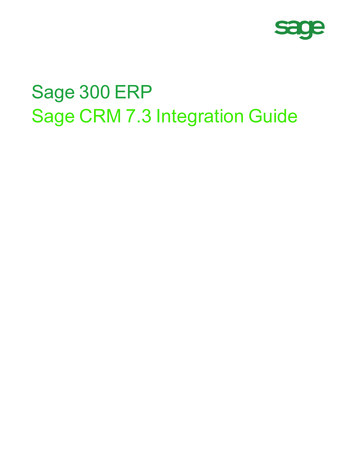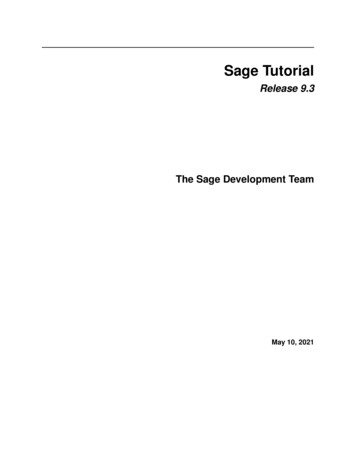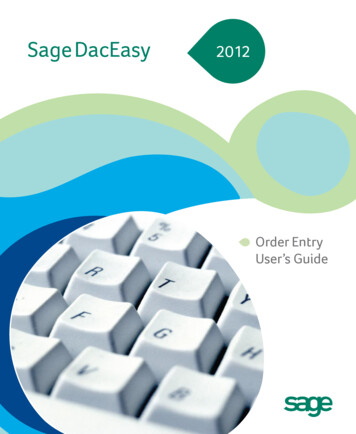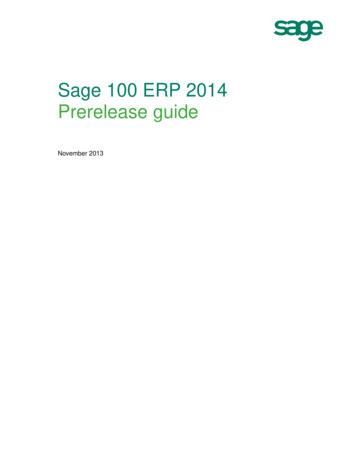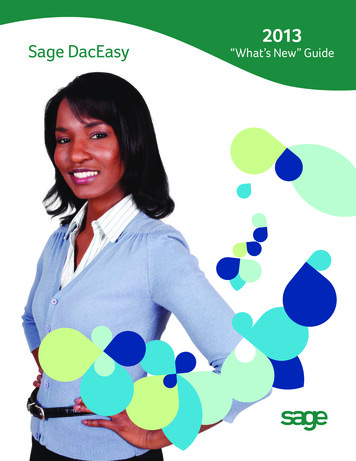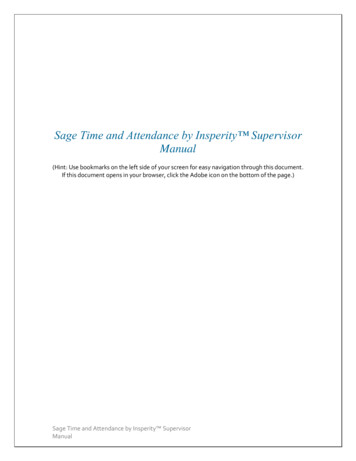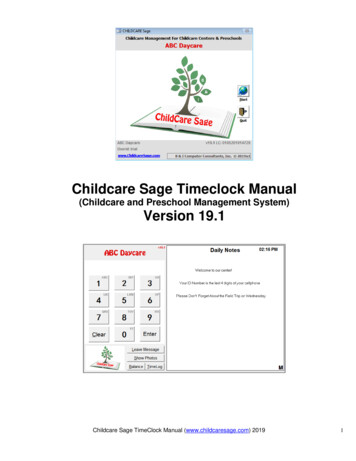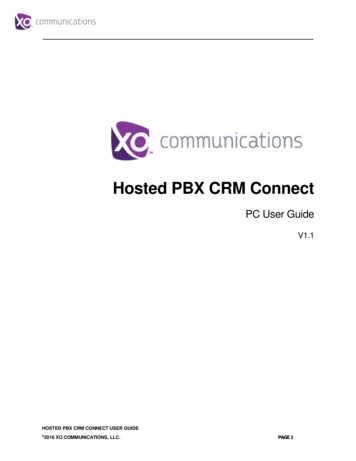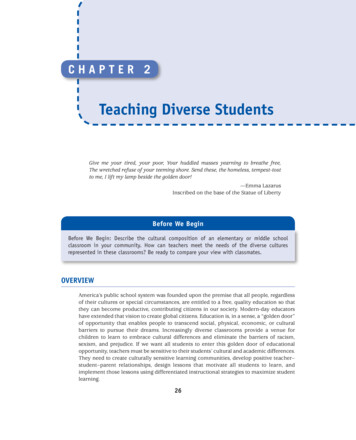
Transcription
CHAPTER 2Teaching Diverse StudentsGive me your tired, your poor, Your huddled masses yearning to breathe free,The wretched refuse of your teeming shore. Send these, the homeless, tempest-tostto me, I lift my lamp beside the golden door!—Emma LazarusInscribed on the base of the Statue of LibertyBefore We BeginBefore We Begin: Describe the cultural composition of an elementary or middle schoolclassroom in your community. How can teachers meet the needs of the diverse culturesrepresented in these classrooms? Be ready to compare your view with classmates.OVERVIEWAmerica’s public school system was founded upon the premise that all people, regardlessof their cultures or special circumstances, are entitled to a free, quality education so thatthey can become productive, contributing citizens in our society. Modern-day educatorshave extended that vision to create global citizens. Education is, in a sense, a “golden door”of opportunity that enables people to transcend social, physical, economic, or culturalbarriers to pursue their dreams. Increasingly diverse classrooms provide a venue forchildren to learn to embrace cultural differences and eliminate the barriers of racism,sexism, and prejudice. If we want all students to enter this golden door of educationalopportunity, teachers must be sensitive to their students’ cultural and academic differences.They need to create culturally sensitive learning communities, develop positive teacher–student–parent relationships, design lessons that motivate all students to learn, andimplement those lessons using differentiated instructional strategies to maximize studentlearning.26
Chapter 2Teaching Diverse Students27OBJECTIVESAfter completing your study of Chapter 2, you should be able to explain why teachers need to embrace diversity and establish high expectations for allstudents, discuss the changing demographics of American classrooms, explain the role communication plays in culturally sensitive classrooms, describe ways to enhance home-school communication, define and describe the various dimensions of differentiated instruction and learningstyles, and explain the concept of multiple intelligences and describe Gardner’s eight areas ofintelligence.Everything you do in your future classroom will center upon meeting the needs of yourdiverse student population. Therefore, you must gain an understanding of all children’sunique academic, emotional, and cultural differences so that you can help them on theiracademic and life journeys. To support a culturally sensitive learning community, you needto design and implement lessons that address all students’ academic needs, learning styles,and multiple intelligences.Modern classrooms are often highly diverse.
28P a rt I S e t t i n gtheS tag eforS u c c e ss f u l L e a r n i n gCLASSROOM DIVERSITYVideo Link 2.1:Watch a videoabout adapting todiversity.Historically, America’s classrooms were populated by students of mostly European descent.Modern classrooms, however, reflect the nation’s increasing cultural diversity. Today, more than25% of the U.S. population is non-European (Tompkins, 2005). Moreover, because of an influxof immigrants and increased birth rate, Hispanic and Asian American populations have grownby more than 20%, and the African American population has increased by 12%. Another formof diversity that impacts many American classrooms is transiency. Approximately 40 millionAmericans move each year, causing the student populations in many classrooms to almosttotally change between fall and spring (Ornstein, Behar-Horenstein, & Ornstein, 2007). As aresult of these trends, more cultures are represented in today’s classrooms, and more foreignlanguages are being spoken in our schools than ever before. Many of these cultures andlanguages have yet to be represented by the formal curriculum.During classroom interactions and instruction, teachers must keep the special culturalneeds of their diverse student population in mind. Please note, however, that students’cultures include much more than national origin or race. The National Council forAccreditation of Teacher Education (NCATE) now defines diversity as differences amonggroups of people and individuals based on ethnicity, race, socioeconomic status, gender,exceptionalities, language, religion, sexual orientation, and geographical area. Thus, teachers must be prepared to identify diverse students’ strengths, weaknesses, aspirations, limitations, and special needs. Today’s classrooms must celebrate diversity.Most classrooms include students who have documented intellectual, physical, and/or emotional exceptionalities. Under the Individuals With Disabilities Education Improvement Act(IDEIA), children with disabilities must be educated in the least restrictive environment (LRE), oran educational setting that is as similar as possible to the one in which children who do not havea disability are educated. In the past, children with special needs were mainstreamed into generaleducation classrooms on a limited basis for a limited number of subjects. Today, mainstreaminghas been replaced by inclusion, as children with special needs are taught full-time in a generaleducation classroom by a regular education teacher and specialists. Some educators believe thatall children benefit from inclusion because it creates an authentic microcosm of the society students will be participating in once they graduate (Karten, 2010; Rea, McLaughlin, & WaltherThomas, 2002).MIGUEL AND JUANITA: A REFLECTIVE CASE STUDYIn the middle of class one sunny September morning, Ms. Ima D. Voss, Smallville Consolidated SchoolDistrict’s K–8 principal, interrupts your lesson. She introduces Miguel and Juanita, two new arrivals whowould be joining your class. Their family has come to Smallville to assist with harvesting the corn andsoybeans. You welcome the twins warmly, find desks and materials for them to use, and continue with yourlessons. At the end of the day, you reflect upon Miguel’s and Juanita’s academic participation and socialinteractions, review their academic records, and ponder ways you can facilitate their educational efforts.1. List the special needs that Miguel and Juanita bring to the classroom.2. How can you address these needs before the harvest ends?3. How can you make Miguel and Juanita become accepted members of an alreadyestablished learning community?
Chapter 2Teaching Diverse Students29What does a diverse classroom community look like? Please complete Reflect and ApplyExercise 2.1, which will check your understanding of the importance of knowing yourstudents’ backgrounds.ReflectandApply Exercise 2.1: Background ImpactReflect Because of their racial, ethnic, cultural, socioeconomic, and intellectual differences,students bring unique needs to the classroom. Consider the geographic area where youplan to teach. Create a concept map, or web, depicting the various cultures representedby the diverse student population. What can you do to learn more about the cultures thatare currently unfamiliar to you?Apply List at least five school and/or community resources you can use to address the diverseneeds of your future students.Teacher ExpectationsTeachers must plan very carefully to ensure that all students participate in high-interesteducational activities that are personally relevant. Failure to recognize and address students’ unique backgrounds could result in a large portion of the future adult population ofthis country who cannot participate successfully as global citizens. Academic experiencesand parental perceptions impact students’ attitudes toward education. To create enthusiastic, lifelong learners, effective teachers show students that what they are learning in schoolwill equip them with the knowledge, confidence, and skills necessary to have fulfilling lives.Teachers’ expectations have a powerful effect on students’ performance. Effective teachers hold high, realistic expectations for themselves and all students. They believe in theirability to create a caring classroom climate and in their students’ ability to succeed. Ifteachers act as though they expect their students to be hard working, interested, and successful in class, they are more likely to be so. Researchers have found that students whofeel they have supportive, caring teachers are more motivated to engage in academic workthan students with unsupportive, uncaring teachers (McCombs, 2001; Newman, 2002).Teachers communicate their expectations and attitudes toward their students throughtheir actions and words. Students’ perceptions of teachers’ expectations and attitudes canaffect their motivation and self-concept. Oftentimes, teachers show favoritism to high achievers by interacting with them more frequently, giving them more time to answer questions,and increasing the amount of positive feedback given to them. Conversely, low-achievingstudents are often seated toward the back of the room, have less opportunity to respond toquestions, receive more criticism for incorrect responses, and are interrupted more frequently. Generally, teachers tend to be more supportive and positive toward capable students.Students’ academic performance and self-esteem are enhanced when teachers set highexpectations and hold them to these expectations. Therefore, teachers need to set realisticexpectations for all students when making assignments, giving presentations, conductingdiscussions, and grading examinations. “Realistic” in this context means that the standardsare high enough to motivate students to do their best work but not so high that students
30P a rt I S e t t i n gtheS tag eforS u c c e ss f u l L e a r n i n g“What did I learn today? My mother will want to know.”Most importantly, effective teachers treat all students the same, regardless of theirculture, socioeconomic status, or special needs. They continuously express their confidencein students’ ability to succeed. This becomes a positive self-fulfilling prophecy becausestudents begin to behave and achieve in accordance with teachers’ expectations. Be aware,then, that students perceive teachers’ actions as a mirror of themselves, so teachers needto challenge their students and communicate a belief in students’ abilities—and mean it.Teaching Students With Special NeedsPublic Law 94-142 (PL 94-142) and its successors require that an individual educationplan (IEP) be written for every student with special needs. These IEPs describe the student’sSOURCE: Created by Ford Button.will inevitably be frustrated in trying to meet those expectations. Teachers should guardagainst setting too low or too high expectations for students with special needs and too lowexpectations for gifted students. To develop the drive to achieve, students need to believethat achievement is possible—which means that teachers need to provide plentiful opportunities for success.Effective teachers help students set achievable goals and encourage them to focus onlong-term improvement, not just grades on current assignments. Students learn to evaluate their progress, critique their own work, analyze their strengths, and address theirweaknesses.
Chapter 2Teaching Diverse Students31abilities, educational and/or socioemotional needs, developmental level, and academic/behavioral expectations. They also identify required instructional modifications and accommodations (Rothstein, Rothstein, & Johnson, 2010). Teachers use this information to differentiate instruction, or customize their instructional delivery to address the needs of all students.Teachers differentiate instruction by modifying the instructional delivery and assignments. For example, they create outlines, concept maps, and other visual aids for studentswho have difficulty processing complex concepts. Teachers record step-by-step instructions for students who are struggling in science labs, while using a traditional lab approachwith general education students. In language arts classes, teachers use recorded books,leveled readers, or optical readers to share quality literature with challenged readers.During the writing process, students who have motor difficulties record their stories orhave scribes. Primary children are encouraged to express themselves through multiple signsystems (pictures, numbers, letters, and pseudo-writing). Emergent and beginning writerscreate language experience stories with the teacher. In math class, struggling students usehands-on manipulatives to demonstrate mathematical concepts; they can also write mathproblems, one digit per square, on graph paper. Other examples of lesson modificationsinclude modified worksheets, individualized instruction, specialized software, modifiedassignments, peer tutors, study guides, oral or hands-on exams, and assistive technology(AT). Some school districts help teachers create differentiated assignments by developingclassroom modification plans for school use. Figure 2.1 shows a sample plan with threecategories. The teacher checks those items that will apply to a specific student.Some planning guidelines for working with students who have special needs follow:1. Gather information about the nature of the exceptional student’s difference andhow that difference might affect the learning process.2. Seek assistance from district special education or resource experts.3. Use specialized equipment (typewriters, computers, DVD player, print enlarger,Braille material, etc.) to allow students to function at an optimum level.4. Individualize the curriculum by adapting materials and teaching strategies tobetter meet the needs of the exceptional students.5. Remove physical and psychological barriers that limit exceptional students’ abilityto succeed in your classroom.Response to InterventionResponse to intervention (RTI) is a relatively new approach to identifying studentswith academic needs that has gained increasing interest. RTI, which emphasizes “studentoutcomes instead of student deficits,” provides early and more immediate support forstudents’ academic needs by screening students as early as kindergarten (Kavale, Holdnack,& Mostert, 2005; Vaughn & Fuchs, 2003). This strategy is used to identify and provide earlyintervention activities so that students who are struggling academically can participateand progress in general education curriculum. Students who are not responding to traditional instruction are provided additional academic support through individualized andsmall-group instruction provided by teachers who use research-based strategies. If students
32P a rt I S e t t i n gFIGURE 2.1theS tag eforS u c c e ss f u l L e a r n i n gClassroom Modification PlanStudent: Teacher:School: Grade/Course:A. Exam Modification1. Reduce the number of exams to2. Open-book exams3. Allow more time for regular exam4. Reduce the length of the regular exam5. Use more objective items (fewer essay items)6. Give some exam orally7. Write down test items for students8. Read test items to student9. Substitute assignment for test10. Enlarge test item print11. Allow use of computer12. Other (specify)B. Assignment Modification1. Provide more detailed directions2.3.4.5.6.7.8.9.10.11.12.13.14.15.Repeat instructionsGive instructions through several channels (oral, written, etc.)Provide materials that are programmed/self-checkingBrief student on major points before starting an assignmentAllow more time for regular assignmentsReduce length of regular assignmentsBreak assignment into a series of smaller assignmentsReduce reading level of the regular assignment (edit, reword)Change format of the instructional materialsUse different format materials to teach the same contentProvide study aids (hints, cue cards, guides, calculators, computers)Provide hands-on activities/physical assignmentsAllow oral presentations/reports/projects/games, etc.Other (specify)C. Content Alternatives1.2.3.4.5.6.7.8.9.Make cassette or CD or DVD recordings of lectures for individual playbackAllow teacher aide/volunteer to take notes for studentAllow classroom peers to make carbon copies of classwork for the studentUse visual (DVDs, charts, pictures, etc.) and/or audio materials (CDs, tapes, records)Use individualized learning contract or learning centersUse computer learning packagesProvide hands-on/learning by discovery experiencesUse self-checking materialsOther (specify)
Chapter 2Teaching Diverse Students33continue to struggle, they receive even more individualized instruction targeting the areaof academic need. Then, students who still exhibit academic difficulties are referred forspecial diagnostic testing and possible special education services.Assistive TechnologyAT enables all students to be successful in the general education classroom. Through the use ofspecialized technology such as closed circuit monitors, Braille readers, voice activated software,TTY telephones, and motorized wheelchairs, students are able to participate in educationalactivities that might have been difficult or impossible otherwise. Indeed, the latest amendmentsto the Individuals With Disabilities Education Improvement Act of 2004 (IDEIA) encourage implementation and development of technology to enhance instruction in regular classrooms. In effect,Congress suggests the effective use of technology reduces and/or eliminates many of the barriersthat block instruction and improves teachers’ ability to better address the needs of all students.Effective teachers develop learning materials and activities commensurate with theabilities of students with special needs, much as they adapt lessons to the individual differences of all students. In doing so, they work closely with available resource teachers, specialists, and other support personnel.Limited English ProficiencyA major challenge facing many school districts in many areas of the country is teaching studentsa second language: English. During this past decade alone, approximately 4.4 million childrenwere English language learners (ELL) (Hancock, 2007). In many communities today, it is notuncommon for more than half the students to come from homes where the first language is notEnglish. In the Los Angeles Unified School District, for example, more than 81 languages are spoken in the homes. Big city school districts in New York City, Miami, and Houston, as well as manysmaller districts, now have populations of ethnic minorities that equal or exceed nonminoritystudents. Nationwide, the number of students whose first language is not English is expected toincrease during the next couple of decades. By 2026, it is projected that about one fourth of allstudents will come from homes in which the primary language is not English. Yet StandardEnglish will continue to be a necessity for success in school and society.Limited English students who are learning to communicate reasonably well in Englishneed encouragement and help. The terms limited English proficiency (LEP) and ELL areused for students who have not yet attained an adequate level of English to succeed in anEnglish-only program. Students who are learning English as a second language (ESL) mayattend special classes for ELL. Some schools use a pullout system, in which part of the student’s day is spent in special bilingual classes or individualized tutoring sessions and part inthe general education classroom. This instruction enables them to learn the major conceptsbeing taught in the general education classroom while they learn English. Other schoolsplace students in sheltered classes consisting of specific cultural groups where the teacher isspecially trained to work with LEP students. School districts who have a high percentage ofESL students often hire bilingual teachers to teach English and ELL students in one classroom.Whatever system is used, teaching students who have limited proficiency in Englishshould include the use of plentiful visual displays, demonstrations, dual language texts, bilingual software programs, physical education activities, hands-on activities, group work,artwork, and cooperative learning (see Chapter 9). Teachers should attempt to communicate
34P a rt I S e t t i n gtheS tag eforS u c c e ss f u l L e a r n i n gwith LEP students through gestures, pictures, and any words they know from the students’native language. Take time to teach English-speaking students some key words, phrases, orgestures so they can build peer relationships as well. Encourage other students to include LEPstudents in their activities, explaining that they can make the new students comfortable byhelping them learn the standard procedures and popular activities. Always maintain a positive attitude, even though attempting to communicate with LEP students may be challenging.Gifted and TalentedMost general education classrooms will also have some gifted and talented (G/T) students(Davis, Rimm, & Siegle, 2010). Teachers should vary the academic content, instructionalprocess, or student products to challenge these G/T students. For example, G/T students candevelop their own hypotheses and experiments in science, create faux interviews or scriptsin language arts, and apply mathematical concepts to solve real-life problems. Help G/Tchildren develop their critical thinking skills using strategies described in Chapter 10.ReflectionsonTeacher Practice 2.1 Working With Parents2. How are parents unrealistic about the function of schools and what schools can accomplish?As an educator, I am familiar with the old “boredom” tale from parents. I listen politelywithout comment. Then I ask them nicely what I can do to make my class more interesting fortheir child. Usually, they don’t have an answer. The real problem is that in this age of instantresults, many parents today expect their child’s entire education to occur within the 6-hourschool day. And they expect it to be individually tailored to their child. Whereas teachersshould consider individual needs, it is unrealistic to individualize instruction for all students.I think many parents and educators have lost sight of the original intent of public educationin the United States. Public education was set up to provide students with a foundation ofskills and opportunities for education. It was assumed that truly interested students wouldcontinue learning at home. Now, with most parents working to make ends meet, I believe theyhave an absolute right to expect more from their child’s school. But because most kids are onlyin school for about 1,200 hours per year, it is unrealistic to expect schools to work miracles.So much has changed in society, but our country’s educational system has not yet caught up.Perhaps we need to restructure our country’s educational system to better address the needsof today’s parents, who, just trying to survive, are often spread too thin to educate their childrenat home. If individualized instruction is what we need to have, then perhaps all students shouldbe designated for “special education,” with smaller classes of students working toward individualgoals. After all, every student has his or her own special needs. As our system works now, onlycertain “identified” students are having their “special” needs met. Is that really fair?Perhaps students should be in school for more hours. I feel like I have so much to “cover” forstandardized tests that my students don’t get the opportunity to practice newly learned skills asmuch as research says they need to. Of course, changes in our educational system will not happenuntil teachers are seen (and ultimately paid) as the highly specialized professionals that we are.—Mary, elementary school teacherPlease visit the Student Study site at www.sagepub.com/mooreteachingk8 for additional discussion questionsand assignments.SOURCE: Reprinted with permission from ProTeacher, a professional community for elementary school teachers(www.proteacher.net).1. What benefit would be gained from extending the school year and student time in school?
Chapter 2Teaching Diverse Students35This completes our study of some of the challenges presented by a diverse studentpopulation. Complete Reflect and Apply Exercise 2.2 to explore the impact of racial andethnic differences on the classroom and to further explore your diversity awareness.ReflectandApply Exercise 2.2: Diversity AwarenessReflect Effective teachers learn about students’ backgrounds and needs, respect all students,avoid using stereotypes, use culture-fair and gender-fair language, and integrate diverseperspectives throughout the curriculum. What qualities and experiences do you possessor lack that might affect your ability to be a teacher who embraces a diverse studentpopulation? How will diversity awareness affect your ability to better work with students, parents, andprofessional colleagues?Apply How will diversity and cultural differences affect your teaching and students’ learning? How can you use racial, ethnic, and linguistic differences to enhance your classroomcommunity and curriculum? How can you adjust your teaching strategies and curricula to better meet the needs of allstudents in your future classroom?MULTICULTURALLY SENSITIVE COMMUNICATIONOf all the knowledge and skills teachers possess, being able to effectively communicate isperhaps the most significant and the most useful. Through communication, teachers teach,colleagues collaborate, and students learn. Without communication, teaching does notoccur, children do not learn, and schools do not function.Children learn both verbal and nonverbal communication strategies through imitating thesignificant others in their lives—their parents and teachers. At home, most American parents onlyconverse with their children approximately 38 minutes per week. Yet, elementary and middleschool teachers communicate with children up to 7 hours per school day (Hansen, 1999). So whohas the most potential impact on how children learn to communicate? Teachers do!Most teacher preparatory programs place a great deal of emphasis on future teachers’ability to read and write with little emphasis given to speaking and the ability to listen.These programs often only require one public speaking course and entirely overlook theimportance of nonverbal communication. The most persuasive teachers do not rely exclusively on reading and writing; they talk, they observe, and they listen.Teachers, therefore, need to become proficient verbal and nonverbal communicators tointeract effectively with all students and all families. Establishing quality teacher–student–parent communication doesn’t just happen; it requires special skills and dispositions suchas good listening techniques, tact, kindness, consideration, empathy, enthusiasm, anunderstanding of parent–child relationships, and an awareness and knowledge of culturalfactors that affect communication.
36P a rt I S e t t i n gtheS tag eforS u c c e ss f u l L e a r n i n gCommunication With ParentsAt the outset of each school year, teachers need to invest time getting to know students andtheir families. These activities will set a positive, professional tone and form a friendlyfoundation for ongoing home–school communication throughout the school year. Manyteachers make home visits, sometimes accompanied by a translator or professional colleague, depending upon the situation. During the visit, they get to know the family, introduce themselves, share their curricular goals and classroom expectations, and answer thefamily’s questions. Other teachers prefer to send a letter of introduction or e-mail to parents that includes classroom expectations, curricular goals, a personal introduction, aninvitation for parental involvement, and professional contact information (see Figure 2.2).If possible, personalize the letter with the parents’ or guardians’ actual names and translateit in the family’s native language if they are non-English speaking. Be sure to have severalcolleagues check for accurate language, spelling, grammar, and punctuation! Send the letter through the traditional mail or e-mail rather than via the black holes of students’ backpacks and lockers. Continue the conversation through positive phone calls, e-mails, notes,newsletters, and invitations for parental involvement throughout the semester or year.Complete Application Activity 2.1, which will give you the opportunity to draft an introductory letter to the parents of your future students.APPLICATION ACTIVITY 2.1 Introductory Letter to ParentsPrepare an introductory letter that you might send to parents at the start of the school year(see Figure 2.2). Share it with your instructor and classmates.LANGUAGE AND CULTURELanguage and culture tend to bind us to others, but they also can separate us from thosewho do not share the same cultural norms (Kabagarama, 1996; Nolan, 1999). Verbal andnonverbal communication often can be a challenge in a culturally diverse classroom. Inmany instances, language cannot be directly translated (word for word) because meaningscan be different. Therefore, it is essential that you understand much more than just thelanguage of your students.Most Americans are unaware of the important role their nonverbal behaviors play incommunicating their feelings and attitudes toward others. This lack of self-knowledgeinterferes with their ability to build student, parent, and professional relationships, especially with people whose cultures differ from their own. Therefore, American children andteachers need to learn the meaning of the gestures indigenous to their own culture andbecome cognizant of cross-cultural nonverbal behaviors. With this knowledge of nonverbalbehaviors, they will be able to communicate more effectively with members of their localand global communities (Hansen, 1999).
Chapter 2FIGURE 2.2Teaching Diverse Students37Sample Letter to ParentsJones Elementary School2004 Elementary School RoadWichita, KSSeptember 5, 2011John and Mary
with general education students. In language arts classes, teachers use recorded books, leveled readers, or optical readers to share quality literature with challenged readers. During the writing process, students who have


